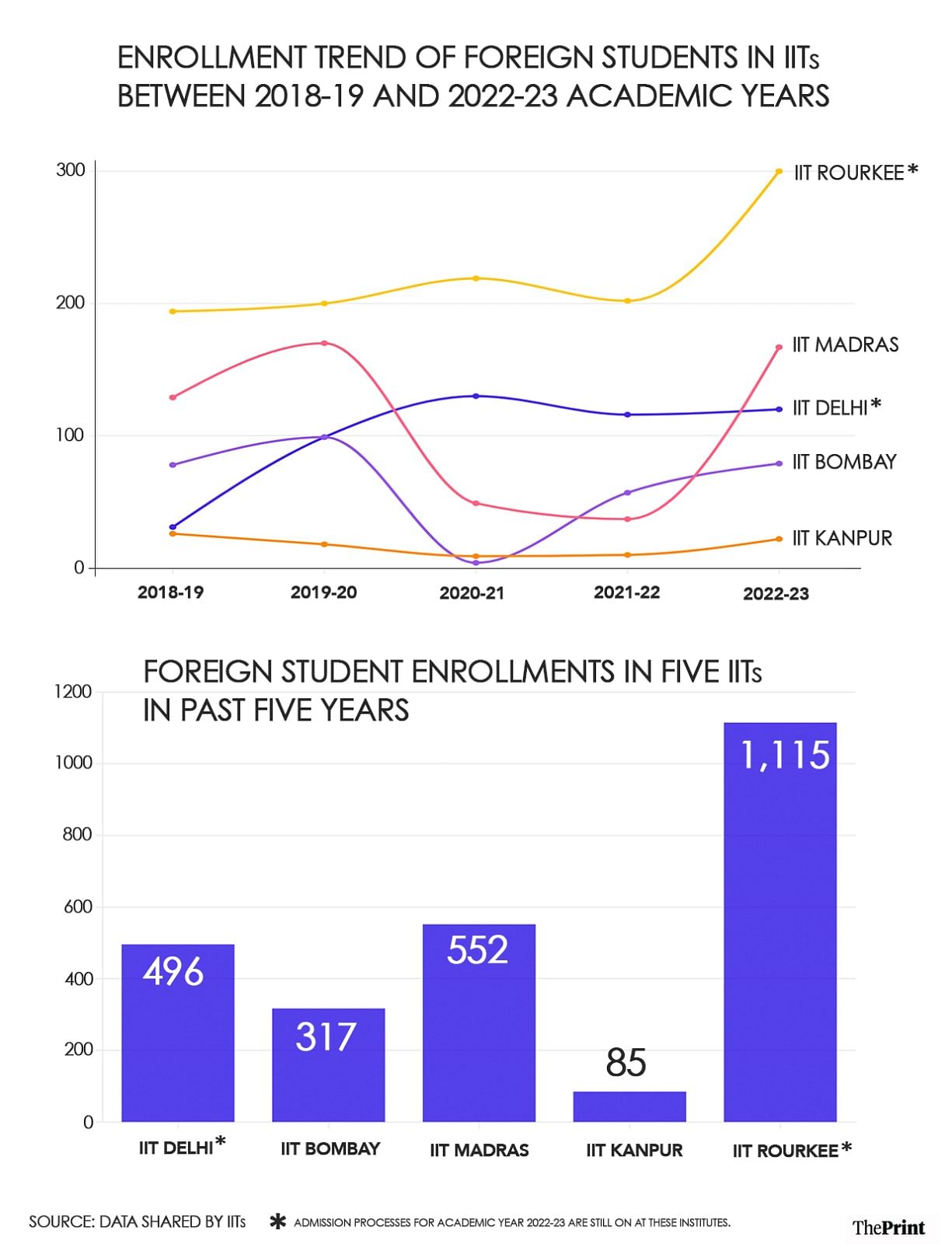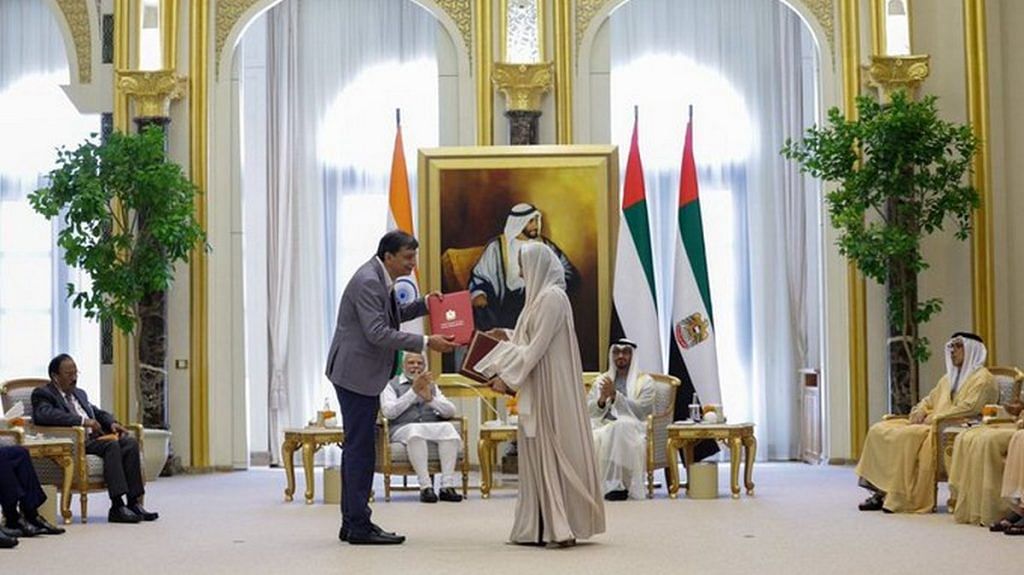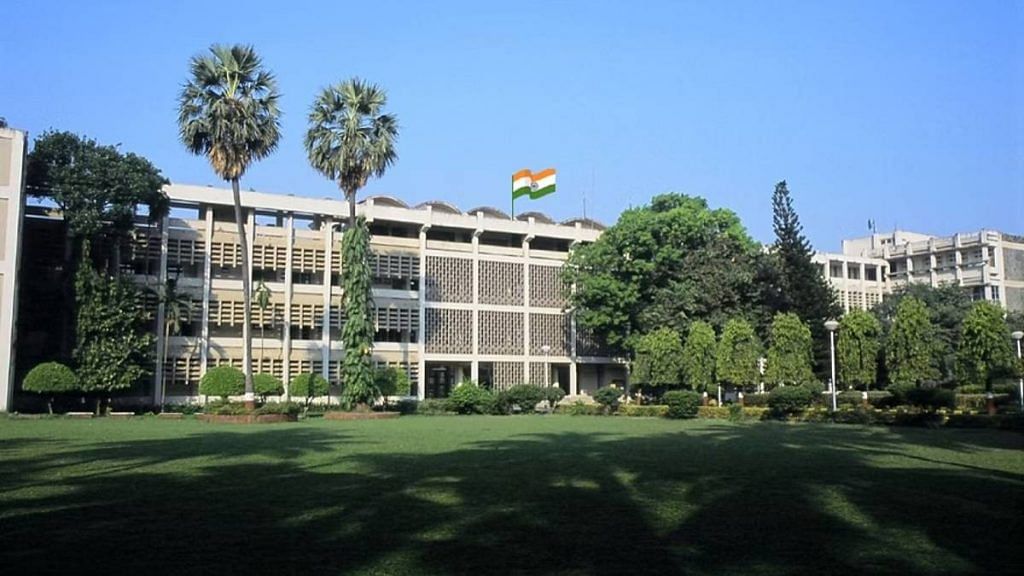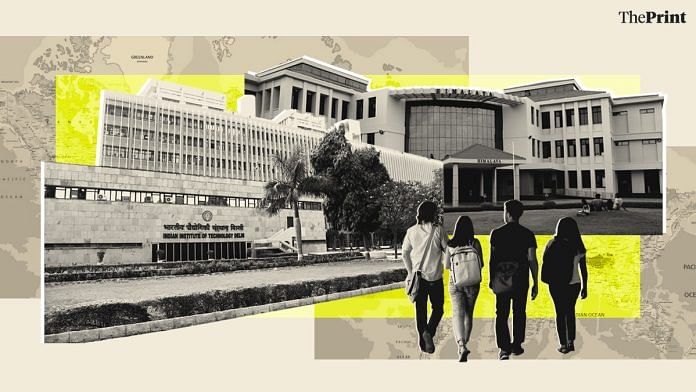New Delhi: The prestigious Indian Institutes of Technology (IITs) have been on a drive to expand their global footprint by setting up campuses abroad. However, their endeavours to attract international students to Indian campuses have received a tepid response despite concerted efforts that started five years ago.
Last Saturday, the Union Ministry of Education inked a memorandum of understanding (MoU) for the establishment of an IIT Delhi campus in Abu Dhabi. Just days prior to this, IIT Madras had sealed an MoU to set up a campus in Tanzania’s Zanzibar.
Back home, though, the IITs, which are centrally funded institutes under the Ministry of Education, have struggled to attract foreign students despite dedicated efforts since 2018— including scholarships, better fee packages, international e-seminars, and joint PhD programmes.

Data shared with ThePrint by the five IITs — Bombay, Kanpur, Madras, Delhi, and Roorkee — reveals that the number of foreign students on their campuses has largely stagnated over the past five years. The only exception to this trend is IIT-Roorkee.
IIT-Delhi witnessed an initial surge in student enrollment, tripling its intake from 31 students in 2018-19 to 99 students in 2019-20. However, subsequent years saw only minor increases, with 120 foreign admissions in 2022-2023.
Similarly, IIT-Kanpur had 26 foreign students in 2018-19, which dropped to 22 in 2022-23. Meanwhile, IIT Bombay’s foreign student population was 78 in 2018-19, with only a marginal increase to 79 in 2022-23.
The number of foreign students at IIT Madras rose to 167 in 2022-23 from 129 in 2018-19. But the institution experienced a significant drop in numbers during 2020-21, with only 49 students, followed by an even fewer 37 in 2021-22.
IIT Roorkee, however, presented a contrasting picture. It witnessed an increase from 194 foreign students in 2018-19 to 300 in 2022-23.
Additionally, Roorkee stands out as the sole IIT to achieve a total enrollment of over 1,000 foreign students in the last five years, with a count of 1,115, far surpassing its counterparts Madras (552), Delhi (496), Bombay (317), and Kanpur (85).
It should be noted that these figures encompass all levels of study, including undergraduate, postgraduate, doctoral, and exchange programmes, as well as internships.
Experts who spoke to ThePrint emphasised that the IITs face the most significant challenges in enrolling foreign students for undergraduate programmes, where the difficulty of the Join Entrance Examination (JEE) is a major barrier.
However, while easier entrance requirements and scholarships do attract some foreign master’s and doctoral students, difficulties in obtaining work visas and funding limitations present obstacles.
Professor Ramgopal Rao, former director of IIT Delhi and current group vice-chancellor of BITS Pilani, highlighted that the Covid-19 pandemic also contributed to a stagnation of enrollments.
“After IIT Delhi was given the Institution of Eminence status (by the Ministry of Education in 2018) We visited the ASEAN countries and spoke with the ambassadors there. We aggressively pushed for increased foreign student enrollment. And over a period of time, we did see some success but then the Covid-19 pandemic led to a global shutdown and our numbers stagnated,” he said.
Here’s a look at the various endeavors of the IITs to attract foreign students and why these efforts have achieved only limited success.
Also Read: Open to non-science students, annual fee of $12,000 — IIT-Madras’ plans for its Zanzibar campus
‘Vishwa Guru’ to ‘diversity’— reasons for foreign push
The National Education Policy 2020 advocates various measures and initiatives to attract more foreign students to the country, aiming to position India as a premier global study destination with affordable yet quality education.
“India will be promoted as a global study destination providing premium education at affordable costs thereby helping to restore its role as a Vishwa Guru,” it says.
In line with this, the policy also promotes research and teaching collaborations, faculty/student exchanges with reputable foreign institutions, and the signing of MoUs with foreign countries. Additionally, it encourages high-performing Indian universities to establish campuses abroad.
Explaining why IITs have been making efforts to increase student diversity on campus, Prof Aghalayam, director in-charge of IIT-Madras’s Zanzibar campus, said it contributes to institutional growth and overall quality.

“It has been increasingly found in academic institutions that diversity is important in the growth and evolution of an institution,” she said.
“A look at the top global institutions shows that a lot of their success is because they opened their doors to students from across the world,” she added.
A plan to attract ‘bright’ foreigners
The IIT Council, the governing body of the Indian Institutes of Technology, decided on concrete strategies to attract foreign students during a meeting on 20 August 2018, although the matter had been the topic of discussion previously as well.
Noting that the quantum of foreign admissions was “not very encouraging” for the undergraduate and postgraduate programmes, the council decided to launch a “country-specific action plan for reaching out to bright students”, according to the minutes of the meeting.
This plan was to be carried out in association with EdCIL, a public sector educational consultancy company that operates under the Ministry of Education. The meeting also noted that the fee chargeable for foreign students would be decided by the concerned board of governors (BoG).
In its next meeting, held on 27 September 2019, the IIT council took another important decision — to grant direct entry to the Advanced Joint Entrance Examination (JEE) for non-residential Indians and foreign students, including Overseas Citizen of India cardholders with foreign passports who had completed their studies abroad.
This meant that these students would be exempted from the requirement to appear for the JEE Mains examinations, which usually has to be cleared to qualify for the JEE Advanced.
This meeting also decided that the IITs would “prepare a scheme for providing scholarships for the bright foreign students” and that a committee would be formed to improve hostel infrastructure for all the IITs.
Reduced fees, scholarships, stipends
Soon after the council’s decisions in 2018, the IITs embarked on individual efforts to bolster their foreign student enrolment, ranging from financial support and international outreach efforts to smoother administrative processes.
For instance, in 2018, IIT Delhi introduced its international PhD Fellowship Programme (IPFP), which sought to attract PhD students from abroad with a monthly stipend of Rs 31,000 for the initial two years and Rs 35,000 per month for the subsequent three years.
Additionally, IIT Delhi established joint PhD programmes in collaboration with the University of Queensland, Australia, and National Chiao Tung University, Taiwan.
Meanwhile, IIT Kanpur reduced the fees for self-funded foreign students, making it equivalent to that of Indian students, effective from the 2023-24 session.
This was a strategic move aimed to address the concern of higher fees hindering enrollment from South Asian Association for Regional Cooperation (SAARC) countries, where the Indian rupee is stronger than the local currency, an official from IIT-Kanpur told ThePrint
“Higher fees for students from SAARC countries has been a great limiting factor. Since the fee for them was high, IIT-K was losing out on those students to IITs with lower fees. We have corrected it and are expecting the number of foreign students to gradually increase in the coming years,” the official added.
In a similar vein, IIT Bombay’s BoG approved a scheme in 2018 to offer financial support to high-performing foreign students in master’s and PhD programmes.
“This support is in the form of a reduced tuition and a monthly stipend. In addition, the institute has been providing financial support to a few top foreign students in the PhD program by providing them stipend,” said Prof Amit Agrawal, dean (international relations) at IIT-B, in a written statement to ThePrint.
He also wrote that IIT-Bombay was actively seeking foreign postdoctoral fellows to collaborate with the institution.
Meanwhile, to encourage international enrollments, IIT-Madras has employed various approaches, including virtual foreign fairs, participation in seminars abroad, and the establishment of joint degree doctoral programmes. It has also facilitated scholarship and tuition waiver schemes for deserving international students.
In IIT-Roorkee, there has also been an endeavour to make the application and admission process smoother for foreign students.
According to Prof Vimal Chandra Srivastava, dean (international relations), at IIT-Roorkee, the institute has
created a unique admission portal for foreign applicants, reducing application processing time, and making the process more transparent and efficient.
Srivastava added that the departments and administration remain in touch with applicants throughout the process to resolve any issue. IIT-R has also set up an International Students Affairs Council (ISAC) with office-holders from different countries.
The second-generation IITs are also making dedicated efforts to boost foreign enrollment.
Prof Tarun K. Panda, dean of foreign relations at IIT-Hyderabad, said that the institute has been “aggressively pursuing” this goal over the past five years.
“In the last three years we have had about 10 students graduate. Three foreign students will graduate in the 2022-23 academic year,” he told ThePrint.
Notably, in a conclave held at IIT-Gandhinagar, leading IITs pledged to increase their foreign student enrollment from 1 to 5 per cent.
The Indian government has been doing its bit too, including the launch in 2018 of a doctoral fellowship giving 1,000 students from ASEAN (Association of Southeast Asian Nations) scholarships to pursue studies in the 23 IITs across India.
In the same year it also started the Study in India programme, which gives scholarships to foreign students to study in Indian universities, including IITs.
Where are students coming from?
According to IIT officials who spoke to ThePrint, some of the most represented countries include Ethiopia, Germany, Nepal, Afghanistan, Bangladesh, Bhutan, and France.
Data shared by IIT-Bombay shows that the greatest share of foreign students over the last five years came from Germany, France, and Nepal. The IIT-B website also details a programme funded jointly by India’s University Grants Commission (UGC) and DAAD (German Academic Exchange Service).
This project, called Exploration: An Indo-German Partnership, brings together the Technical University of Munich, IIT-Bombay, and IIT-Kharagpur to advance research in vital areas such as climate, environment, energy, mobility, and transportation.
In IIT-Madras, too, the greatest number of students are from Germany. According to Prof Preeti Aghalayam, dean of School of Science & Engineering & director-in-charge, Zanzibar campus, IIT Madras, many of such students are enrolled at the India-German Centre for Sustainability.
“We have had great research ties with several German institutes in the fields of sustainability and allied areas of research and innovation. We have several faculty members and students who have collaborated and spent semesters as a part of project-based research and exchange programmes,” she said.
IIT-Roorkee’s Prof Srivastava, on the other hand, said that the institute gets most of its students from Africa, South-East Asia, and the Gulf countries.
Among African countries, he said the majority of students come from Ethiopia, Tanzania, and Sudan. Srivastava pointed out that IIT-Roorkee leads the DST-Africa initiative, an intercontinental initiative to promote research and academia under the aegis of the government’s Department of Science &Technology.
He added that IIT-Roorkee has also taught many students from Nepal, Syria, Bangladesh, and ASEAN countries.
Srivastava said that for master’s programmes, courses related to water resources and development, civil engineering, computer science, mechanical engineering, electrical engineering, earthquake studies, and chemical engineering are the most sought-after. For PhD programmes, all departments receive nearly equal preference from foreign students, he added.
According to data provided by IIT-Delhi, the most foreign students came from Nepal, Ethiopia, Afghanistan, Bangladesh, and Sudan. For Kanpur, the foreign students were from Ethiopia, Nepal, Bangladesh, and Bhutan.
Challenges in attracting students
This year, IIT-Bombay became the first among the 23 IITs to enter the top 150 in the prestigious QS global rankings. However, all IITs, including Bombay, scored relatively low on the parameter of internationalisation, or foreign student enrollment.
On this front, ranked IITs’ scores range from 1.4 to 2.2, compared to a global average of 21.4 for all 1,600 ranked universities. IIT-Roorkee received the highest score among all Indian universities at 2.2.

So, what accounts for these figures?
A significant percentage of foreign students are enrolled in master’s and doctoral programs due to scholarships, fellowships, and easier entry criteria.
Enrolling foreign students for undergraduate programmes, however, has been more of a challenge for the IITs.
In 2022, for the first time, a total of 66 foreign nationals were offered seats through the Joint Entrance Examination (JEE). In the five years prior to that, this number had not surpassed 10.
In 2021, due to COVID-19 and declining student interest, no foreign examination centers for JEE were allotted. Providing work visas and employment opportunities remains the biggest challenge for foreign master’s and doctoral students, according to IITs.
For postgraduate and doctoral programmes, limited funding is another restricting factor for students from many countries.
“IITs provide admission to international students for PG and PhD programmes through the application screening process. Students are either sponsored by established government-regulated or approved agencies, or they apply through the “Study in India” (SII) platform by EdCIL. The sponsorship or funding criteria limit the number of international students. Most of the students who apply to join IITs, look for funding support,” said IIT-Roorkee’s Srivastava.
Difficulties in procuring work visas and jobs after getting their degree also remain a deterrent for students.
“Many students go abroad to study with a view of working in the country after that. Indian work visas are challenging to negotiate. Nepalese students, for example, can work in India on much easier terms and we have the largest interest from students in Nepal,” said Prof Raghunathan Rengaswamy, dean (global engagement), IIT-Madras.
A call for ‘flexibility’, systemic changes
During the IIT Council meeting in April this year, the topic of increasing foreign student presence on campus was again extensively discussed.
In this meeting, Rajat Moona, director of IIT-Gandhinagar, proposed offering foreign students opportunities for six-week to year-long internships at IITs. He further suggested granting credits to foreign students attending one or more semesters, which would be valid in their respective universities.
However, experts say that while methods such as scholarships and internships have their place, there is also a need for strategic efforts to address systemic issues.
Former IIT-Delhi director Ramagopal Rao said it was difficult to pull in many foreign students or international faculty due to limitations of funding and infrastructure.
“Since we are funded by the tax-payers’ money, we cannot incur huge expenses on foreign students. In addition to this we don’t have enough foreign faculty for the same reason — there is no provision for foreign nationals to get permanent government jobs. Foreign faculty can be an important pull factor in increasing student enrolment,” he noted.
Another former IIT faculty member added that instead of foreign faculty collaborations on research, IITs need to focus more on institutional partnerships.
Speaking to ThePrint, a former IIT director, wishing to remain anonymous, said that there needed to be more flexibility in the undergraduate admission process in IITs.
“At the undergraduate level, alternative exams need to be introduced. As for the master’s and doctoral levels, examinations other than the Graduate Aptitude Test in Engineering should be considered,” he said.
“A lot of NRIs in Asia and the Middle East would happily send their children to IITs,” he added. “But the admission processes for foreign students need to be made simpler to attract them.”
(Edited by Asavari Singh)
Also Read: ‘Need well-rounded professionals’ — why IITs, IIMs & IIITs are giving humanities a new thrust



